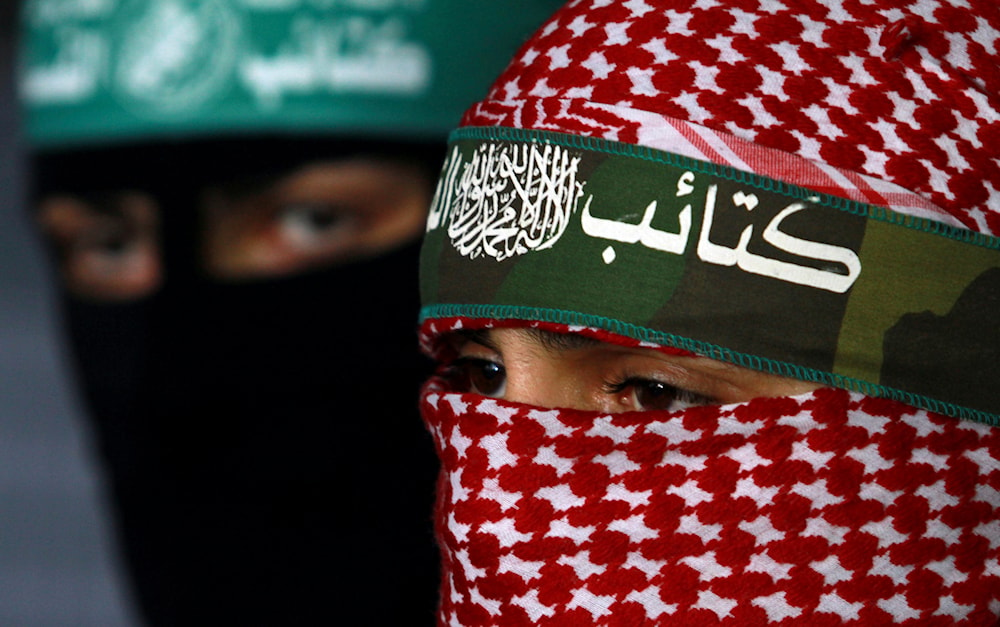Sources reveal details of Cairo's proposal, Hamas' response: Exclusive
The proposal includes the release of 40 Israeli captives, including women, children, and the elderly, in exchange for the release of 900 Palestinian prisoners, including 100 with life sentences.
-

Masked Palestinian Resistance fighters hold a press conference in Gaza City, on Saturday, April 9, 2011. (AP)
Exclusive sources within the Palestinian Resistance revealed to Al Mayadeen detailed points of the mediators' proposal presented to the Hamas Movement, clarifying the movement's position on it as well.
The proposal is made up of three stages, each stage lasting 42 days.
First stage:
The first phase revolves around the gradual return of displaced civilians to the northern Gaza Strip, with no specified numbers mentioned, while acknowledging that the previous proposal entailed the return of 2,000 displaced individuals per day.
This phase additionally involves the implementation of temporary housing arrangements in the northern region, overseen by a United Nations team to ensure the safe return of the displaced individuals.
In addition, 500 aid trucks will be delivered daily, with a portion allocated to the northern region, including tents and caravans. Moreover, efforts will be made to rehabilitate hospitals, health centers, and bakeries, while restoring infrastructure such as roads, water, electricity, sanitation, and communication networks. Furthermore, equipment for debris removal will be allowed entry.
For its part, Hamas objected to the issue of the gradual return of the displaced.
The proposal also suggests that Israeli forces relocate themselves from densely populated areas to locations designated by "Israel" on a map. But Hamas rejected this proposal, deeming the term "outside densely populated areas" as vague, which would grant "Israel" the authority to control these areas and establish a buffer zone. However, at the same time, Hamas agreed to the presence of the occupation forces at the border, on the condition that a complete withdrawal is eventually carried out.
The proposal also included "Israel's" approval of opening al-Rashid and Salah al-Din Streets, with Israeli forces stationed 500 meters away from them.
Hamas rejected this proposal and instead demanded a withdrawal to Salah al-Din Street and a withdrawal from al-Rashid Street. They proposed that Israeli forces be stationed at the "Netzarim" junction as part of the first stage. However, they emphasized that at the end of this stage, all forces must withdraw outside the borders.
The proposal also includes the release of 40 Israeli captives, including women, children, and the elderly, in exchange for the release of 900 Palestinian prisoners, including 100 with life sentences.
Regarding the issue of prisoners, there are two main problems:
According to the sources, the first issue is that "Israel" demanded the release of 40 captives. But if there aren't enough children, women, and elderly individuals among them, then it insists on the release of male captives. Hamas rejected this condition.
The second is that the proposal includes the right of “Israel” to deport whomever it wants from life-sentenced prisoners, which Hamas also rejected.
Second stage:
The sources revealed to Al Mayadeen that the agreement between the two sides includes "the release of all Israeli captives and a return to sustainable calm." However, Hamas considered the term "sustainable calm" unclear and emphasized that the second stage did not include any information regarding a ceasefire or a complete withdrawal of Israeli occupation forces.
The second stage also did not specify the number of Palestinian prisoners to be released, according to the sources.
Third stage:
The exchange agreement includes the bodies and remains of killed Israelis and Palestinian martyrs. The sources revealed that the agreement is fully guaranteed by Egypt, Qatar, and the United States.
Hamas affirms adherence to 'natural demands'
This comes after the Hamas delegation affirmed on April 8 the movement's adherence to its natural national demands during negotiations for a ceasefire in Gaza.
During a meeting with the Egyptian Minister of Intelligence, Abbas Kamel, in the Egyptian capital Cairo, the Hamas delegation emphasized the necessity of achieving an agreement that fully halts aggression, ensures the withdrawal of Israeli occupation forces from Gaza, and allows displaced people to return freely to their areas and places of residence, as well as provides relief to the Palestinian people and initiates the reconstruction of what was destroyed by the Israeli occupation.
Hamas added that a prisoner exchange deal must be concluded, whereby Palestinian detainees are released in exchange for Israeli captives held by the Palestinian Resistance in the Gaza Strip.
The movement reiterated its commitment, along with all Palestinian forces and factions, to achieve national objectives and establish a fully sovereign Palestinian state with its capital al-Quds, and the right of return and self-determination.
Read next: Temporary Gaza ceasefire possible despite Israeli hurdles: Exclusive

 5 Min Read
5 Min Read








